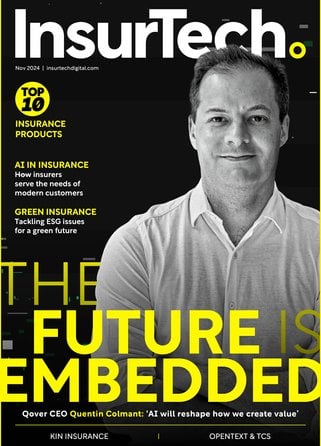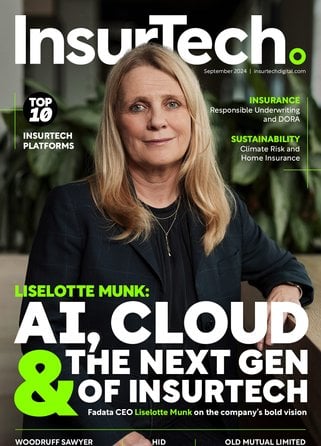Insurwave: Big data is now the ‘lifeblood’ of insurance

The way data is used in insurance is taking the industry to new heights. Leveraging machine learning and AI, insurers can streamline services for customers and offer innovative new products.
We talk to Insurwave’s Chief Strategy Officer, Richard Archer, to get his take on the ways big data is levelling-up insurance, and the things slowing down legacy players.
How are you seeing big data enhance the insurance process?
Data is the lifeblood of the insurance market. Data platforms can transform how insurers do business. Especially when augmented by advanced technologies, such as artificial intelligence (AI), machine learning, and advanced analytics.
These technologies can accelerate the submission to quote process and improve risk selection, claims/loss analysis and portfolio optimisation. With access to big historical data sets, insurtechs can also provide real-time dynamic exposure monitoring and scenario analysis to offer new risk mitigation and loss prevention services.
However, the payoff from investing in these technologies hinges on solving the insurance industry’s fundamental data ingestion problem.
Data at legacy insurers is unstructured and scattered. Why?
The majority of legacy insurers’ data is still unstructured and scattered across slips and bespoke schedules of assets that are all vastly different. Similarly, many large data sets remain locked in legacy policy administration and claims management systems that are difficult to interrogate.
Additionally, line slips, binders and other types of delegated business still rely on sharing large, cumbersome, semi-structured bordereaux, formats that are difficult to process and consume.
The complexity of these document and data formats means insurance markets only process what they need to support their quoting, pricing and binding. So lots of market data is therefore left untouched.
ACORD (Association for Cooperative Operations Research and Development) data standards and key market initiatives such as SDC (structured data capture), and CDRs (core data records) are helping promote the importance of better-structured data.
However, this is predominantly focused on post-bind accounting and settlement processes. Less so on driving adoption of standardised data “up front”, during pre-bind submission and quote tasks.
Without machine learning and AI, data would be far less useful. What defines the relationship of these technologies?
The interplay between big data, machine learning and AI isn’t merely a futuristic concept. Leading carriers are already taking advantage of technology like AI so they can move their attention away from basic tasks toward increasing their capacity, focusing on bigger volumes of transactions, identifying patterns and developing actionable insights.
Specifically, the time from submission of data to actionable insights can be cut from days to mere minutes. But automation can also support real-time decision-making and give underwriters new insight into exposures.
Furthermore, the foundation of higher-quality data sets the stage for increased rigour in risk management, simplified reinsurance processes and enhanced claims administration.
If insurers can master the art and science of data management they can generate a lot more value from their assets. They’ll also be able to increase returns on their investments in technology and expand their ability to use AI effectively.
Moreover, they can accelerate and scale their digital transformation programs more broadly across the business.
How is data being used to support different customer preferences and demographics?
The management and sharing of data by insurance buyers is continuing to drive frustration, with many demanding a change to how data is used and maintained.
With insurance buyers starting to better manage their own data and better understand their own risks and exposure, we are seeing a shift in terms of what risks are being transferred and also retained - a big example being the rise in risk retention through captives.
If data is better structured and captured, it will provide new insights for insurers to offer more tailored coverages and target different markets or pools or risks that fall within certain appetites.
This may drive more coverage for certain markets, or indeed reduce allocation of capital to certain types of risk - impacting coverage and in turn further driving changes in insurance buyers’ desire to retain more risk themselves, especially given the current environment of a hard market.
As premiums increase and coverage terms and capacity are restricted, risk and insurance managers have to up their game as long-term relationships enjoyed in a formerly soft market have broken down.
With risk managers facing increasing scrutiny of their submissions, high-quality data has never been more important as they compete with their peers for scarce capacity.
How else can big data be used in the future?
From accelerated quoting capabilities and optimised underwriting to more precise insights into real-time risk exposure to higher technology ROI and reduced costs, insurers are looking to intelligent automation to break free from legacy system constraints and realise the potential of advanced technology.
By improving the flow of data, the lifeblood of the industry, insurers can rejuvenate the health of the entire business.
Consider how higher-quality data and fully transformed underwriting workflows can instil real-time decision-making and risk selection much earlier in the trading lifecycle. By digitising previous contracts and proposals and integrating real-time feeds of relevant third-party data, skilled underwriters can apply their expertise to fuller and richer data sets much more quickly than before.
Exceptions are automatically routed to the right person for review in the step of the workflow. And no senior underwriters, actuaries or analysts are forced to do their own data entry. The risk selection process gets both shorter and more intelligent.
******
For more insights from InsurTech Digital, you can see our latest edition of the InsurTech Digital here, or you can follow us on LinkedIn and Twitter.
You may also be interested in our sister site, FinTech Magazine, which you can also follow on LinkedIn and Twitter.
Please also take a look at our upcoming virtual event, InsurTech LIVE, coming on 18th-19th October 2023.
******
BizClik is a global provider of B2B digital media platforms that cover Executive Communities for CEOs, CFOs, CMOs, Sustainability Leaders, Procurement & Supply Chain Leaders, Technology & AI Leaders, Cyber Leaders, FinTech & InsurTech Leaders as well as covering industries such as Manufacturing, Mining, Energy, EV, Construction, Healthcare + Food & Drink.
BizClik – based in London, Dubai, and New York – offers services such as Content Creation, Advertising & Sponsorship Solutions, Webinars & Events.




